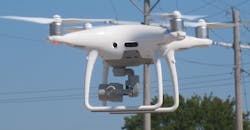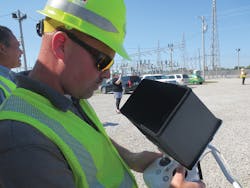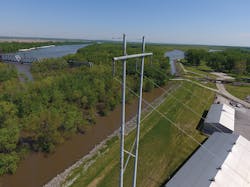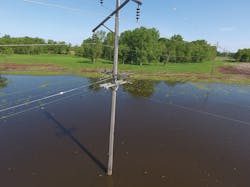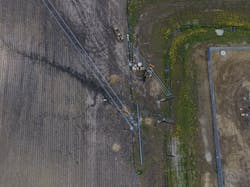Drones Take Flight at Ameren Illinois
A small white drone gently lifted off the ground, hovered in the air and then sailed over Ameren Illinois’ Turkey Hill substation and transmission lines in Belleville, Illinois. Using a handheld controller, a licensed commercial drone pilot carefully navigated the unmanned aircraft system up in the air, over the infrastructure and then back to the starting point.
For the past year, Ameren Illinois has been using drones to observe damage after a storm, survey terrain and inspect thousands of miles of poles, power lines and natural gas facilities. The utility has successfully incorporated the unmanned aircraft systems, also known as drones, into daily operations to help pinpoint where crews should be dispatched to perform work.
“The drones save a lot of time, and they make work safer for our employees,” says Richard J. Mark, chairman and president of Ameren Illinois. “If trees are down, wires are tangled and the terrain is difficult to get through, we can use drones to identify what the problems are so our crews can make repairs.”
For example, when a section of Ameren Illinois’ service territory flooded, a line crew brought in a significant amount of equipment to assess the damage and make repairs. This experience inspired Kyle Maxwell, superintendent of electric operations and chief pilot, to test if he could get faster results using a drone.
“After purchasing a drone, I was sitting at home, thinking of different uses for it,” he says. “Where I live, we have a section of line that runs through a swamp, and the only way we can access it is by boat. I decided to fly my drone over this line to take some video, and that was the starting point to where we are today.”
Maxwell showed the video to the leadership at Ameren Illinois, which then invested in the drone technology to increase the productivity and safety of its field workforce. Shortly thereafter, Ameren Illinois personnel were able to use drones to begin increasing the safety of the workforce and improving the operational efficiency of its system.
Ironically, months later, that same drainage ditch flooded a farmer’s field surrounding a sub-transmission line within a 12-kV underbuild in Beardstown, Illinois. Maxwell flew a drone into the area to pinpoint the issue on a 1-mile section of line. Within 15 minutes, he discovered that high winds blew a jumper connection apart on a dead-end structure and caused an outage. Without the drone, the field crews would have to access the line by boat and then climb five or six poles, which would have taken an hour or even longer.
“It saved time because our line personnel still had to go on a boat, but they only had to go up one pole,” says Riley Adams, manager of electric initiatives for Ameren Illinois. “It got the lights on more quickly for our customers, and it was safer for our crew.”
Selecting a Drone
In the past, the Federal Aviation Administration (FAA) mandated that drone operators had to earn a private pilot license in order to fly a drone. In August 2016, however, the FAA changed the ruling to allow operators to fly a drone after obtaining a drone license certificate. This change in regulations opened the door for many commercial industries to invest in drone technology including Ameren Illinois and other utilities.
After looking at a lot of different models, which suited both its employees and contractors, Ameren Illinois selected the DJI Phantom 4 drone, which has a 25-minute battery life. This drone, which features a high-quality camera, is easy to fly and costs about $2000. To fly this drone, an operator needs to ensure that he or she is linked to the proper GPS satellites, Maxwell says.
“You have very basic controls up and down, and they are very simple to run,” Maxwell says. “You just need to make sure you go through a checklist before you fly the drone to make sure everything is working.”
In addition to the Phantom 4 drones, which can be purchased at Best Buy, the utility purchased a few higher-end DJ S100 drones, which retail at about $16,000 and feature an eight-motor drone and tanks underneath.
“The clarity of the pictures from the drones and the amount of detail that we can get from the video helps our linemen and field workers to expedite the work that they need to do,” Mark says.
Unlike other drones, the units that Ameren Illinois selected feature stability controls, which allow the operators to change the pitch or speed of the motor or adjust it so it is not blown off course. Also, they can take anywhere from hundreds to thousands of hours of video.
“The stability is amazing,” Adams says. “You can let go of the controller, and the drone will stop right there and hover in midair.”
The drones also have a return-to-home feature, so even if the operator loses sight of it, it will go up to about 100 ft and then come back to the starting point. As long as the drone does not crash into a tree or another stationary object, it will generally be safe to return to home, Adams says.
At Ameren Illinois, pilots keep their own drones. If a motor must be replaced, they take the drone to a factory-certified site. For more minor adjustments, such as replacing blades, drone operators can access the stock of parts at Ameren Illinois, which has everything they need to keep the drones operational.
Training on the Technology
Before the change in FAA regulations, Ameren Illinois hired contractors to fly the drones, but today, the utility can now train its in-house resources. By empowering its own employees to serve as drone pilots rather than relying upon contractors, Ameren Illinois can minimize outage times. And because its employees know the circuits, they quickly know what is wrong and what needs to be fixed, leading to a quicker response time.
To be able to fly the drones, the operators must earn a FAA drone certificate. To be trained on the technology, the Ameren Illinois employees attend a two-day training course with Southern Illinois University’s aviation and aeronautical department in Carbondale, Illinois.
During this course, certified pilots teach the 16 students everything they need to know about flying a drone, from reading an aeronautical chart to flying a drone safely. At the end of the course, they must take a randomly generated 60-question test. Ameren Illinois has taken the requirements a step further by requiring its 36 drone pilots to log 20 flight hours and successfully complete an internal flight training course.
Each of the licensed drone pilots is assigned a drone, and during the training, they become familiar with the technology, learn how to use the camera, and fly near lines and close to substations. Without this extensive training, it would be hazardous for the pilots to fly the drone, so by offering further instruction, Ameren Illinois is making the work safer for the customers as well as the pilots.
So far, approximately 36 pilots have passed the 20 hours of flight time, and Ameren Illinois has invested in 45 drones. The utility first started training engineers familiar with circuits as well as construction supervisors. In addition, the utility also has trained vegetation management professionals on how to use drones to locate problem trees.
The drone operators then share these images with the line crews and later tag them with their asset number and archive them for future reference. As part of the second phase of the project, Ameren Illinois plans to train 10 union linemen on various crews as part of a pilot project. That way, they can use the drones within the field for their daily operations and discover new benefits.
“The linemen love the drones, and many of them have them for their own personal uses,” Adams says. “We plan to ask these linemen to take photos with the drones and share them with the rest of their crews so they can figure out how to get in and out of a location and make their work more efficient.”
Currently, personnel in the line and gas departments are using infrared cameras for hot spots, and by using drones, they can see a problem up-close, such as cracked porcelain, and make repairs before the problem escalates into outages. On the gas side, the personnel are looking for drone technology that can help detect gas leaks or sniff the gas. Because the drones are operated by a battery, rather than gas, they won’t ignite a spark, which could result in an accidental fire.
Performing Drone Inspections
Currently, the utility has trained several pilots who are using the drones for daily operations. The drones are designed to fly over a line and indicate what must be done in terms of repair, terrain and egress. The company plans to use drones to survey completed work near rights-of-way to record potential damage incurred by crews. With this approach, the utility can survey the land and quickly calculate a fair price to pay the landowner for the damage.
The utility is planning to train two or three engineers and operating supervisors at each of its 44 operating centers to fly the drones. The licensed drone pilots can store the technology in the back seat of their vehicles. That way, they can use the drones for storm response as well as for daily operations.
For example, if a pole top is in poor condition or a problem is suspected with a conductor, linemen usually need to set up a bucket truck to inspect it more clearly and closely. Today, however, an engineer or construction supervisor can fly the drone into position, snap a photo or record a video, and then pilot it back to the home base. Then the team can review the images to examine the issue and determine what needs to be repaired.
One of the key benefits of the drone technology is that it is safer for the Ameren Illinois personnel. For example, if the crews have to travel on an off-road section or an area dense in vegetation, and a lot of power lines are down, they can rely on a drone to investigate the damage. In the past, the utility would send out four to six field workers, who would be exposed to many hazards such as a creek, downed wires and uprooted trees.
Today, a drone operator can snap images and then look at the screen to figure out what is wrong. Next, he or she can develop a work plan and safe ingress and egress routes, which are safer for the employees. In addition, the drone operator can show the images on a large-screen TV so the entire team can zoom in on important details such as nuts and bolts.
“We have a lot of porcelain insulators and cutouts, and many of them crack over the years, and they get de-energized and fall apart when operated with a hot stick,” Adams says. “Now they can inspect the porcelain to verify the integrity with a drone before they even climb up a pole.”
Drones can greatly improve the safety of the field workforce, Adams says. “The more we can use drones to identify what is wrong in advance of a lineman going up in that energized zone, the better,” he says. “You can easily identify cracked porcelain from the ground with a drone rather than having to set up a bucket truck.”
Looking to the Future
The more drones that Ameren Illinois gets into the air, the more ways the utility will discover how to use them, Adams says. While today’s drones offer a lot of different features, however, there are limitations. For example, operators can’t fly drones at night or within restricted areas. Additionally, they can’t fly the drones within 5 miles of airports or near military bases, prisons or bridges, or in proximity to other aircraft. To ensure that they know where it is safe to fly, the FAA has a GPS-locating app that operators can download on their smart phones.
Currently, operators also must fly a drone within their line of sight. All the drones are programmable, however, and by viewing Google Earth images, operators can dictate exactly where they want a drone to stop to take a video or photo.
“When you develop a flight plan for a drone, it’s armed to a certain extent,” says Adams, who has been in the electric utility industry for 31 years. “You press a button, and it will fly all by itself, stop above a pole, take a picture and do whatever it is programmed to do. It’s really designed to go beyond the line of sight, but the FAA is not allowing that yet.”
If the FAA does give the green light on flying beyond the line of sight, Adams says it will lead to big benefits for Ameren Illinois customers.
“We hope that we will be able to go beyond the line of sight soon on our transmission system,” he says. “We use helicopters to patrol these lines now, but if you could program a drone to fly over a line, it would be a lot of cost savings.”
In addition, the drones are often operated by lithium polymer batteries with a 20- to 25-minute life. Some drones are gas-powered, but these units can cause a fire if they collide with another object.
At this point, Ameren Illinois can’t fly the drones at night without a special waiver. Although the drones do have a light to illuminate dark areas, it drains the battery life and does not do an effective job of lighting an object at night. In the future, if the drones offered a quality night vision image, it would help the utilities to identify issues before the sun rises, therefore restoring power more quickly to customers.
Today, more than 300 vendors manufacture drones, and to educate themselves about the different technology available, Ameren Illinois employees have attended drone expos, which can provide a wealth of knowledge.
The drones are now in their infancy, and as other utilities learn how to use the drones, Ameren Illinois hopes that the technology will become even more suited to the utility industry, rather than just to the general public. To truly fit the needs of the industry, the drones need to not only be reasonably priced, but also waterproof, reliable, have a quality zoom lens and be equipped with an infrared camera.
With these technological advancements and a drop in cost, drones one day could fly over power lines and substations nationwide, therefore maximizing the efficiency of line crews, protecting the field workforce and increasing the speed of restoration.
Maxwell says drones are like another tool in a lineman’s toolbox. For years, he says linemen have relied upon binoculars, and drones are like the next wave of this technology.
“One day, I see linemen having drones on their trucks, and when they go out into an area, they can take the pictures themselves,” he says. “While we are not there quite yet, I can see that happening. Until then, we can use drones to make our system more reliable because we will be getting quicker results. Also, it will be much safer for our linemen because we are putting a drone — not a lineman — out there to see what we want to see.” ♦
Sidebar: Top Three Benefits of Drones at Ameren Illinois
Ameren Illinois delivers electricity to 1.2 million electric customers and 816,000 natural gas customers across 1200 communities and 43,700 total sq miles. By using drones, the utility is able to improve safety, save time and increase efficiency for its field crews.
1. Enhance storm and emergency response. By using drones to assess storm damage and emergency situations, Ameren Illinois is able to improve the safety for the field workforce in challenging work environments. For example, emergency and storm response situations expose workers to unforeseen hazards, from dealing with downed power lines in heavily wooded areas to working in standing water near electrical infrastructure. By mounting a camera on a drone, a licensed and trained operator can direct the drone to the damaged area and complete an initial aerial assessment. Crews on the ground can watch real-time video from the drone and identify the exact location of problem areas, resulting in safer restoration for crews and faster restoration time for customers.
2. Inspect poles and natural gas facilities. Ameren Illinois has natural gas facilities and 1.3 million utility poles throughout its service territory. Using the drones, the company can inspect energy-delivery equipment or perform normal day-to-day maintenance. While workers normally need to enter the energized zone and be in close proximity to live wires to evaluate the damage, drone pilots can identify problems by flying over power lines or other infrastructure. With this approach, crews can obtain the information necessary to complete repairs swiftly and safely. By using drones to locate and make an initial evaluation of damaged equipment, it not only improves the employee safety, but also the efficiency and speed of repair operations.
3. Survey terrain. Drones give Ameren Illinois employees another tool to use when surveying land considered a location for new electric or gas infrastructure.
Check out the January 2018 issue for more articles, news and commentary.
About the Author
Amy Fischbach
Electric Utilities Operations
Amy Fischbach is the Field Editor for T&D World magazine and manages the Electric Utility Operations section. She is the host of the Line Life Podcast, which celebrates the grit, courage and inspirational teamwork of the line trade. She also works on the annual Lineworker Supplement and the Vegetation Management Supplement as well as the Lineman Life and Lineman's Rodeo News enewsletters. Amy also covers events such as the Trees & Utilities conference and the International Lineman's Rodeo. She is the past president of the ASBPE Educational Foundation and ASBPE and earned her bachelor's and master's degrees in journalism from Kansas State University. She can be reached at [email protected].
